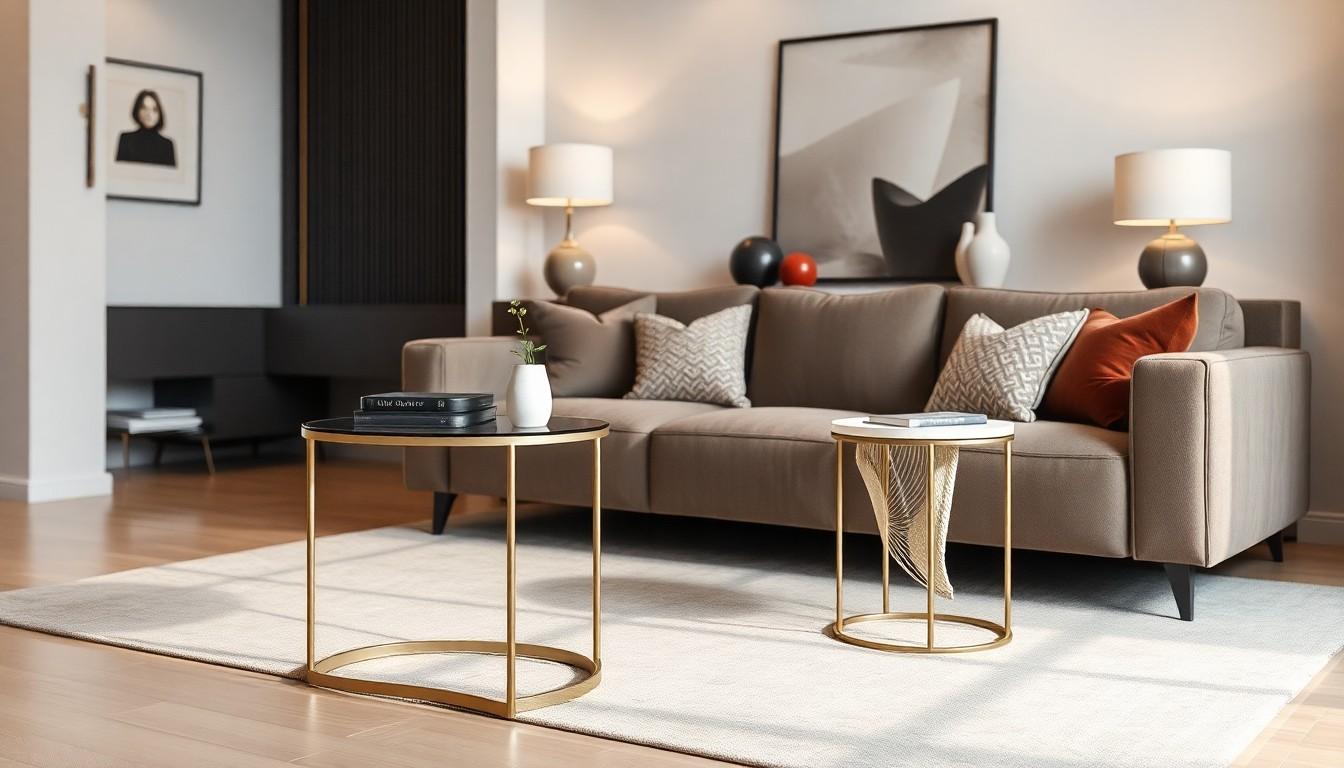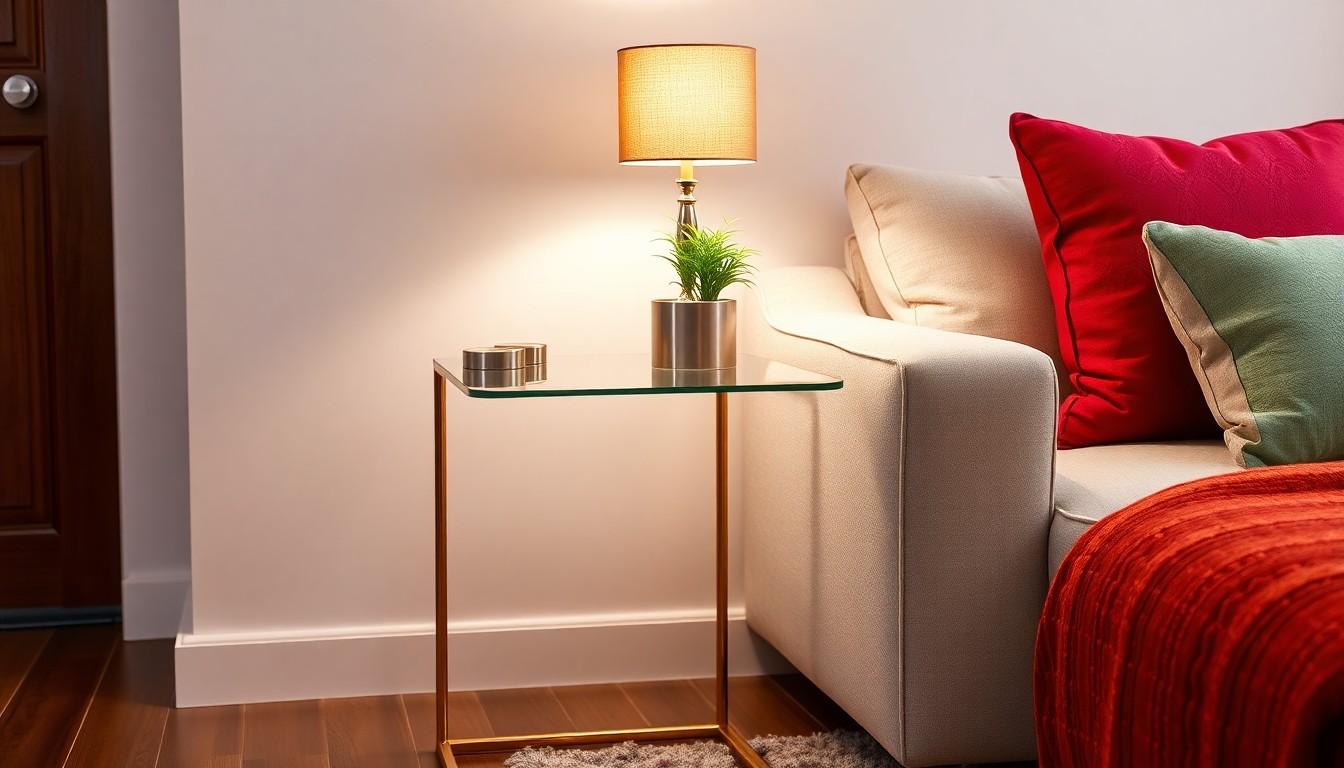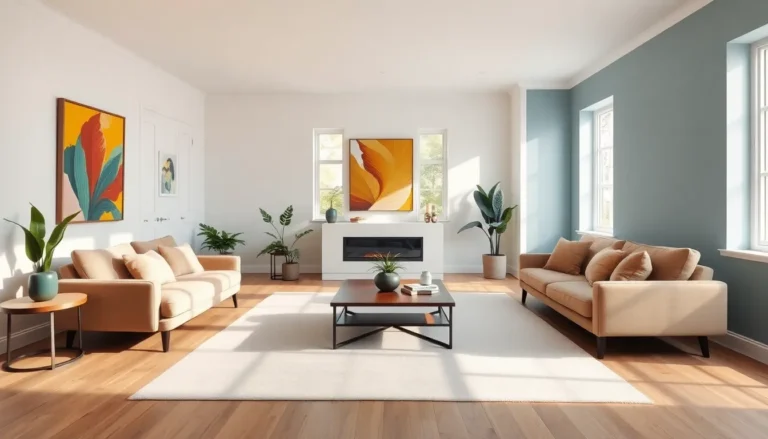In the world of living room decor, side tables often play the unsung hero. They might not steal the spotlight like a flashy sofa or a trendy rug, but these little gems sure know how to make a big impact. Imagine a cozy evening with a book in one hand and a steaming cup of coffee in the other, perfectly perched on a stylish side table.
These versatile pieces aren’t just for show; they’re the ultimate multitaskers. Whether it’s holding snacks during movie night or showcasing a beloved lamp, side tables effortlessly blend function with flair. So why settle for a boring old table when you can elevate your space with one that reflects your style and personality? Let’s dive into the world of side tables and discover how they can transform your living room into a stylish sanctuary.
Table of Contents
ToggleOverview of Side Tables for Living Rooms
Side tables offer both utility and style in living rooms. They serve various functions, acting as supports for drinks, books, or decorative items. Common materials include wood, metal, and glass, allowing for diverse design options to match decor themes.
Versatile in nature, side tables can fit in numerous spots within the living space. Placing them beside sofas or chairs creates convenient access points. Selecting the right size ensures they don’t overpower other furniture while remaining functional.
Designs vary widely, from minimalist to ornate. Some feature storage options like drawers or shelves, adding extra practicality. Others stand out with unique shapes or finishes, contributing to the room’s overall aesthetic.
Maintaining balance in decor enhances the visual appeal. Coordinating side tables with existing furniture or color schemes can unify the space. Choosing complementary lighting helps highlight these small but impactful pieces.
Alternatives to traditional side tables exist. Nesting tables provide flexibility, allowing easy relocation. Rolling carts offer mobility and can double as mobile bars or serving areas when needed.
Accessorizing side tables elevates their functionality. Adding coasters protects surfaces while keepsakes can personalize the space. Layered decor, such as stacked books or plants, enhances visual interest and invites conversation.
Examining current trends reveals a shift towards multifunctional designs. Eco-friendly materials gain popularity, appealing to sustainability-focused consumers. Incorporating technology, like charging ports, meets modern-day needs and keeps living rooms up to date.
Styles of Side Tables

Side tables come in various styles, each offering unique characteristics that enhance living room aesthetics.
Modern Designs
Sleek lines and minimalist forms define modern side tables. Often featuring materials like glass and metal, these designs emphasize functionality without sacrificing style. Round or rectangular shapes can introduce a contemporary feel to any space. Adding bold colors or unique patterns may create a striking focal point. Many modern options exhibit clean finishes and geometric shapes, allowing them to blend seamlessly with current decor themes.
Traditional Options
Ornate detailing and classic shapes characterize traditional side tables. Often crafted from rich woods like mahogany or cherry, these pieces exude elegance. Curved legs and carved accents enhance their timeless appeal. Functionality remains key, with some featuring drawers for convenient storage. Coordinating these tables with boxy sofas and rich fabrics complements the nostalgic atmosphere typical of traditional interiors.
Rustic Looks
Textured finishes and natural materials define rustic side tables. Made from reclaimed wood or distressed finishes, these tables bring warmth and charm to living rooms. Designs vary from chunky styles to simpler forms, maintaining a rugged aesthetic. They pair well with earth-toned decor, enhancing a cozy, inviting atmosphere. Whether placed next to a cozy chair or in front of a sofa, rustic tables contribute to a laid-back, comfortable environment.
Materials Used in Side Tables
Side tables come in various materials, each contributing distinct characteristics and aesthetics to living room decor. Understanding these materials helps in selecting the perfect piece.
Wood
Wood remains a popular choice for side tables due to its natural beauty and durability. Different types of wood, such as oak, maple, and walnut, offer unique grain patterns and color tones, enhancing visual interest. Many homeowners appreciate wood’s ability to create a warm, inviting atmosphere. Craftsmanship often varies, with some tables featuring intricate carvings or sleek finishes. Solid wood usually provides stability and strength, while engineered wood offers a more budget-friendly alternative. Maintaining wood side tables involves regular polish to preserve their shine and protect against scratches.
Metal
Metal side tables provide a modern and stylish vibe, often found in contemporary decor. Steel, aluminum, and brass are common materials used for their resilience and sleek appearance. These tables frequently come in various finishes, such as matte, brushed, or polished, allowing for diverse design options. Because of their lightweight nature, they are easily movable, making them suitable for dynamic living spaces. Some designs feature mixed materials, combining metal with wood or glass for added interest. Aluminum particularly excels in outdoor settings due to its rust resistance, ensuring longevity.
Glass
Glass side tables introduce a sense of elegance and airiness to living rooms. Often paired with metal or wood frames, glass tabletops create an illusion of spaciousness. Various thicknesses and styles exist, from tempered glass to frosted finishes. Many like glass for its reflective properties, which enhance lighting and dispersal in a room. Cleaning is straightforward, typically requiring just a glass cleaner and cloth to maintain clarity. Incorporating glass side tables adds a contemporary touch, making them ideal for modern spaces focused on minimalism and lightness.
Functional Uses of Side Tables
Side tables provide essential functionality in living rooms, serving multiple roles beyond aesthetics.
Storage Solutions
Storage solutions often feature side tables that include drawers or shelves. Some tables offer hidden compartments, ideal for stashing away remotes or magazines. A well-chosen side table can keep clutter at bay, enhancing the room’s organization. Various styles ensure that storage blends seamlessly with existing decor. Many modern designs incorporate open shelving, allowing easy access to items while maintaining a clean look. Smart storage enhances both functionality and style.
Decorative Elements
Decorative elements elevate side tables beyond mere utility. Unique lamps, artwork, or decorative trays can transform side tables into focal points. Adding plants introduces visual interest and freshness to the space. With various styles available, side tables can complement other decor elements in the room. Layering decorative items creates depth, inviting conversation. Thoughtful accessorizing contributes to the overall ambiance, showcasing personal taste while maintaining balance.
Tips for Choosing the Right Side Table
Selecting the ideal side table involves considering various factors, ensuring it complements the living room’s overall look and function.
Size and Scale
Size and scale play critical roles in selection. Side tables must fit comfortably next to sofas or chairs, providing easy access to drinks or books. Measure available space before purchasing to avoid crowding the area. Consider the height of the table; it should be close to the arm height of adjacent seating for optimal functionality. A small table might suit compact spaces, while larger designs can work well in more expansive areas. Prioritizing proportion prevents imbalance in the room’s aesthetic.
Color and Finish
Color and finish significantly impact the table’s integration with existing decor. Choose colors that coordinate with dominant hues in the room for a cohesive look. Neutral tones like white or gray blend seamlessly with various styles, while bold colors can create vibrant focal points. Finish type also matters; a glossy surface adds sophistication, while rustic finishes can warm up the atmosphere. Consider the texture as well, as it contributes to the table’s overall visual appeal. Aligning colors and finishes with other furniture pieces promotes harmony throughout the space.
Side tables are more than just functional pieces; they’re essential elements that can elevate a living room’s decor. By selecting the right style and material, individuals can create a space that reflects their personality and enhances comfort. Whether opting for a sleek modern design or a rustic charm, side tables offer versatility that caters to various needs.
Accessorizing these tables thoughtfully can further enhance their appeal and utility. From decorative items to practical storage solutions, the right choices can transform side tables into striking focal points. With careful consideration of size, color, and design, anyone can achieve a harmonious balance that brings their living room to life. Embracing these small yet impactful additions can lead to a more inviting and stylish home environment.




